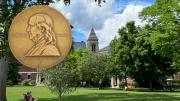Merchants, attorneys, and preachers—that’s what Ishvarchandra Vidyasagar half-jokingly associated with British colonialism in India in the nineteenth century. The expansion of trade and government under the British East India Company brought changes in everything from landholding and revenue collection to legal practices and judicial systems, while the advent of Protestant missions occasioned vigorous debates about religion. Perhaps no single event better encapsulates the tensions associated with colonial rule than the 1829 British ban on suttee, the custom of burning Hindu widows on their husbands’ pyres. If there were Indians, like the great Rammohun Roy, who supported the ban, there were others who contested the nature and purpose of such intervention. Both Rammohun and his opponents were members of a new class of Hindu elite who began to form voluntary associations, publish pamphlets, and enter into public debate over religion, law and social custom.
This is the world into which Vidyasagar was born and upon which he would leave his impress. A promising Brahmin child from a family of scholars of limited means in rural Bengal, young Ishvarchandra Bandyopadhyay arrived in Calcutta just as the ban on suttee came into effect. Though he never met Rammohun, he would in time inherit the older man’s mantle, proving himself both a formidable Sanskrit pandit (scholar) and a courageous social reformer.
In Calcutta, he initially lived in squalid conditions while studying at the Government Sanskrit College (established by the British in 1824). His mastery of traditional subjects like grammar and rhetoric along with his playful intellect led his teachers to bestow the title by which he is universally known: Vidyasagar (“the ocean of learning”). In 1851, he became the first Indian principal of the college and, eager to institute reforms of his own, he advocated the improvement of Sanskrit learning and the promotion of vernacular education. He was as demanding as he was innovative; one pandit confessed he no longer had the courage to speak to his former pupil.
Discrimination was also a fact in colonial Bengal. Recommended for the position of inspector of schools, Vidyasagar had to settle for the position of assistant inspector; the higher post was reserved for a European. Even so, he was entrepreneurial enough to recommend changes in Bengali instruction that required new schoolbooks, many of which he wrote and published himself. He often used his wit to confront discrimination indirectly. Denied admission to a museum while wearing his sandals, he drafted a complaint in which he confessed to being baffled by the “mystery” of footwear among the British. When his British counterpart at the Hindu College received him seated, with his feet on his desk, Vidyasagar received his colleague the same way at the Sanskrit College. He would later explain: “I thought that we were an uncivilized race, quite unacquainted with the refined manners of receiving a gentleman visitor. I learned [my] manners…from that gentleman himself….”
Proud of his Brahmin heritage and moved by dreams of improvement, Vidyasagar like Rammohun sought to yoke the resources of Sanskrit tradition to the task of social reform. In this vein he challenged several deeply held customs, opposing child marriage and high-caste polygamy, while advocating for Hindu widow remarriage (vidhava-vivaha), the cause for which he is best known. Proud of his Brahmin heritage and moved by dreams of improvement, Vidyasagar sought to yoke the resources of Sanskrit tradition to the task of social reform.
High-caste Hindu custom forbade widows to remarry. With suttee banned, attention turned to the plight of these women, enjoined by custom to lives of penance and ostracism. Vidyasagar traced his convictions to an incident in which a poor widow fed his hungry father. Anyone who could witness the “love, compassion, and goodness” of this widow and not become an “advocate for women,” he claimed, would have to be “the most vile and ungrateful person on this earth.” The publication of his 1855 treatise on the subject, based on his mastery of Hindu law, is often credited with convincing the government in 1856 to grant Hindu widows the legal right to marry. Vidyasagar judged this his “single greatest good deed,” but his fellow pandits scorned him as “new-fangled” and composed numerous tracts in opposition to his proposal.
Then, in 1857, the “Mutiny” of native troops against their East India Company officers rocked India. In its wake, the British tempered their policies of reform while Hindu intellectuals began to promote the defense of their own customs. Vidyasagar left government service a year later. The 38-year-old cited exhaustion and increasing disappointment with British policy. Yet he remained active until his death, aiding malaria victims, caring for widows and orphans, and pursuing his work as an author and reformer. The heyday of reform had passed, though; his campaign against polygamy in the 1870s came to naught. Plagued by poor health and disappointment, he retreated in 1873 toKarmatar in western Bengal, where he built a home and provided homeopathic care to the tribal population. Today a modest memorial stands in his garden there. On the plinth are the words of poet Rabindranath Tagore, who had read Vidyasagar’s schoolbooks as a boy and who in the early twentieth century saw in him traits essential for imagining a new Indian nation. While his life and legacy continue to be debated, Vidyasagar’s courage and compassion, like his quest to enliven tradition for the purpose of change, continue to inspire.
![Photograph by Brian A. Hatcher The inscription below this bust of Vidyasagar quotes Rabindranath Tagore: “The chief glories of [his] character were neither his compassion nor his learning, but his invincible manliness and imperishable humanity.” The presence of a garland speaks to the reverence many still feel for the man.](/sites/default/files/styles/16_9_180x101/public/img/article/0414/mj14_page_051_01.jpg.jpeg?itok=x93Wy1wk)








